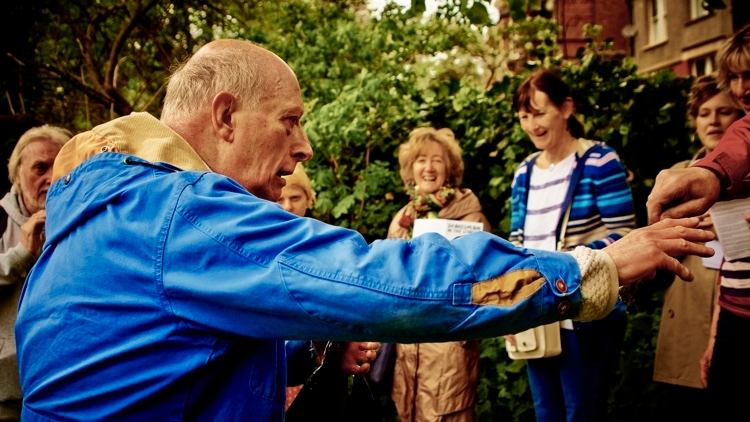 Lightbulbs from Unsplash.
Lightbulbs from Unsplash.
tl;dr Theatre websites are broken, and I want to fix them with my new project. I have struggled to get an affordable portfolio Wordpress theme with no customisation to properly represent my work and I see the same for small theatre companies and individual theatre makers across the performing arts. There are some great agencies out there creating websites that demonstrate how good things can be, but their specialist services are out of reach to most.
Beautiful websites that sell tickets should be affordable and available to every theatre maker.
In early 2015 I had gone freelance and was seeking clients as a digital product and project manager whilst striving to keep one foot firmly in the world of the performing arts.
I was soon in a meeting with a producer, telling him about some of my more off-the-wall theatre and digital ambitions (topical weekly musicals written for podcast distribution, things like that) when he asked if, in my new freelance capacity, I could have a look at redeigning his website. “Of course!” I said.
Working through what that site could be, combined with extended conversations with my web design colleagues, there was a question we kept coming back to:
“Why redesign just one theatre website when we know there are a lot of other companies and theatre makers facing exactly the same challenges?”
The truth is, theatre websites are very specific beasts and difficult to get right. The most common approach I see from friends and colleagues is to get a Wordpress blog set up and find a theme that will let them use individual blog posts for each of their productions.
There are platforms other than Wordpress that you can use to build a website, but no matter which you use, you’re forced to compromise on how you tackle show-specific aspects like listings, actor and creative biographies, headshots, press quotes, star ratings, video trailers, production photography and how your integrate your existing social media activity.
 Shakespeare in the Streets 2014 production photography by Mark Dawson.
Shakespeare in the Streets 2014 production photography by Mark Dawson.
I’ve been in this position myself with Shakespeare In The Streets (above) - the occasional promenade Shakespearian Sonnet Walk we’ve produced in New York, Liverpool, London and Bury St Edmunds. I personally set up categories for each of our productions and then used blog posts for individual performers and their performances. It works. Kind of. Almost.
The other thing that is key to remember is that your website should be one of your most powerful tools to help you engage with your audience.
No where else do you have total control over your content, its appearance and the ownership of any data you collect. On each of the social media platforms you use they have overall control over the experience, the level of engagement and, ultimately, the contact details of the audience you’re interacting with.
Your potential audience are only that, your potential audience, until they’ve bought a ticket to your show.
All too often I’ve seen friends and colleagues set up sites for their companies that are visually compelling but then rely on a row of text links through to the box offices of theatres they are touring to. Of course, each venue is using a different box office system, so when you click through you might even just end up on the venue’s homepage. Then you have to seek out the production, and then indivdual performance you want to book for. At each step of the process you are alienating your potential audience and jeopardising sales.
I appreciate there are agencies out there that do incredible work on theatre websites. One of the common themes in all of my previous jobs has been to trawl theatre websites for information about performers, companies, shows and venues and I’m never surprised when the beautiful and functional site I’m on has a Made Media or Feast Creative logo in the footer.
I also know these boutique design and specialist digital agencies feel out of reach to most small companies and individual theatre makers.
I want to really spell out what I think every theatre website could and should be.
I’m writing this post to elicit feedback - so the people that do this day in and day out can tell me I’m crazy and barking up the wrong tree - but also so that the theatre makers (who realise probably don’t think about websites day in and day out) know what should be possible.
These are not just empty words, I’ve got designers, web developers and a Chief Technology Officer (CTO) who can actually help me realise these plans.
I’m hoping that theatre makers will agree, once a platform is created, that it is worth the time and effort to move their websites and, ultimately, improve the experience for everyone using their websites.
Most importantly, I believe theatre websites can be changed for the better and am determined to make that happen.

Your website should be beautifully designed and look great on every screen
Problem: It’s critical that audiences can easily find information about you, your shows and book tickets whether they’re looking at your website on their phone, tablet or desktop.
That might sound like a huge jump from the status quo, but many complex websites allow this automatically today. The modern web has moved towards responsive design, where a developer creates a series of rules to reorder and resize content when it is displayed on different screens.
What’s more, Google has started penalising websites that aren’t mobile-friendly in their mobile search results. This means that if you’re current site causes users to pinch and zoom to read information or scroll to see whole Images, you’re not just making it difficult for your audience, you’re making it less likely that your audience are going to be able to find your site at all.
Solution: I want to offer a collection of responsive themes for theatre websites that make a single show, the work of a theatre company, or the programming of a multi-space building look fantastic.
Whatever your scale of theatre making, your website should elegantly handle each production. Presenting production information is quite different from a Wordpress blog post, it’s going to involve a title, author, maybe a producer or co-producer that needs credited above the title, run dates, a key pull quote or subtitle and, most importantly, a ‘book now’ link. All of this in addition to your production art or title treatment.
I want to work with great designers to think each of these elements through and make sure they are adaptable to the needs of real companies and, cruically, are easy to set up and use.
The thinking doesn’t stop there. Each of your shows is then going to have lists of cast and creative credits - headshots for your actors (which all need to be the same size and might need to be made black and white), probably no headshots for your creatives - more press quotes, screeds of five-star reviews, running times, synopsis, script licensor credits, lists of producers, content warnings, disclaimers and funders logos. Again, your average Wordpress theme doesn’t make this easy for you and neither do other paid website creation platforms like Wix, Squarespace or Weebly.
The platform I am creating will build on the work of great web designers for a collection of themes, allowing companies to choose from hundreds of Google Fonts, colour schemes and layout configuration.
If you just want to display one production on your homepage there’ll be a template for that. If you want to showcase three on a carousel at the top with rows of your upcoming or past productions underneath there’ll be a template for that too. If you have access to a web designer you should be able to completely take control of the appearance, making it entirely customisable.

Your website should help audiences find your performances and buy tickets easily
Problem: So you’ve got a beautiful website for your show, you’ve directed your audience to it through your marketing and social media channels and your potential audience member is about to become a paying audience member by clicking your ‘buy now’ button. They’re re-directed to the homepage of the venue you’re touring into to next week. Now they’ve got to scour the theatre’s website for your listing.
It amazes me how often this happens. When selling online, marketers talk about a ‘conversion funnel’ where they recognise that for every step you make a customer take to buy something online, the greater the chance that they’ll drop off not complete their purchase.
By not re-directing your ticket buyer to as specific a listing as possible you are adding at least two or three steps to the purchase process as they find your show, select a performance date and time and then start chosing their ticket type or seating location.
Solution: Let me be clear, I don’t want to start building box office software. There are a number of companies large and small working hard to solve problems in that field and, for the most part, are offering hosted box office software.
As a theatre maker, each of these box office systems should allow you to take your performance listing information and display it directly on your own website in just a few clicks using an API.
Ideally this API would also give your website details to display like whether a performance is sold out or has limited availablity - we’ll see investigate what’s possible with individual box office providers.
Even if the theatre you’re working with doesn’t use box office software that provides listings data via an API, you should still be able to add performance dates quickly and easily to your website before link your listings to individual performance purchase pages.
You should also be able to tag that certain shows are previews, when your press night is, if you’re having a ‘relaxed’ performance and make your whole performance schedule easily visible on your website.
Displaying this level of detail on your website - rather than letting your audience just click to the host venue’s homepage - allows you to gather incredibly important information: which performances your audience is looking to book for. But we’ll come back to that.

Your website should help you share the story of your company, artists and productions with your audience
Problem: Every theatre maker is a storyteller. I would argue that some of my friends and colleagues are master storytellers, yet when you visit the websites of many theatre companies they feel totally static and there to deliver information rather than engage and delight audiences about the work that’s being creating and that they can come and see.
Many theatre companies have embedded their Twitter feeds on their homepages, but without context 140 characters that change every time someone tweets do not create a narrative around a company or a production.
Worse still is the trend - which I thought had been dying down but alas not - of retweeting every positive thing that your audience has said about your performance the night before.
There is certainly a value to positive audience tweets - if you display them next to information about a production they might be the thing that tips the balance between someone thinking they should see your show, and actually booking a ticket. Unfortunately, most website creation tools will not allow you cherry pick tweets like that and with most themes and tempates you’ll probably just end up embedding your whole feed in a sidebar.
Solution: There is story in every aspect of the work that we make. There is engaging narrative in how we choose or devise the work that we stage. The bio of every actor we work with is an under-utilised story that plots their experience, contributing to the performance they deliver.
The story of our productions is made up not just of what we might say about it, but what others say about it too. It was wonderful to see how many of her (very recognisable celebrity) friends wished Maria Friedman good luck on the first day of rehearsals for the Old Vic’s High Society.
Every Instagram picture that a cast member posts from rehearsals, photo of the designer’s costume sketches that you put on Facebook, the professional rehearsal shots that you share on Twitter and your production press photography can all be drawn together to help build a narraitve around your production.
Musical theatre productions might have multiple songs published on platforms like SoundCloud in anticipation of their opening. Producer Danielle Tarento has recently gone to the expense of creating two great preview videos of her leading ladies singing numbers from upcoming London musical projects. These videos have been posted on YouTube, but nowadays could also have been on Facebook or Twitter and just as easily be embedded on your own website.
It doesn’t matter which social media platform you, your cast and collaborators are putting time and effort into using, your website should be the backbone to that strategy and should help you form a lasting memory of each show. That, in turn, builds the story of your company.
Why just retweet positive feedback about a show when your website should allow you to curate content from around the web, annotate it, give it context and embed it. To some extent this is what the Storify platform allows you to do - expertly used here by Paines Plough to gather audience feedback - but yet again the content is sitting on a seperate service and not on your own website.
This type of social media curation should be available to all storytellers and theatre makers; letting you curate the story of your work online and harnessing the content that you’re creating on platforms across the web to help you drive ticket sales on your own site.

Your website should help you measure, understand and grow your audience and update you with regular reports
Problem: As an industry we have an issue with data. Touring companies that rely on the host venue for box office services often have little or no customer marketing data and no access to the audience their work has attracted to a venue.
There is a long history of this, but the reality is this leaves touring companies shackled to venues and unable to directly engage those who have previously seen their work. This, in turn, puts them on the back foot when trying to attract their audience to new productions.
I would also suggest our data issue stretches into the digital world. Small companies and individual theatre makers all too often find it difficult to know if what they’re doing online or in social media is making a difference to the size of their audience or their ticket sales.
Solution: Your website should be great at capturing audience data and setting it up to do that needs to be simple and straightforwards.
The thing is, people have become increasingly cautious about entering their email addresses online because they anticipate their email address will be shared or sold and they will recieve spam. In order to make it worth their while, websites have to demonstrate value to their audience.
If you’re offering someone an MP3 from your most recent production, send it to them after they enter their email address. Make it very clear that you’re going to look after it and respect their privacy, but reward them for giving you their contact details by providing them with something of value.
The value you provide doesn’t have to be in the form of a digital ‘product’. If your most recent show has just finished its run but people are still coming to your website for information about it or your company, offer the opportunity to be emailed when your next show goes on sale. Here the value is the convenience, so they don’t have to remember to come back to your site and check. Are your tickets going to be in high demand? Offer people who subscribe to your mailing list a window of advanced sales ahead of general purchase.
If your performance one evening is sold out, don’t just deactivate the ‘buy now’ button on your website - offer people the chance to be notified by email or text message if returns become available. Now you’ve got the details of someone you know wanted to see your show but couldn’t.
At all times, advise the customer what they’re signing up for and ask their permission to contact them with marketing beyond the initial reason for their engagement. All of this can be achieved by carefully integrating a company’s website with an email marketing service like Mailchimp.
My second bugbear here is reporting and analytics. As a theatre maker chances are you’re getting a box office report sent through automatically to see how your ticket sales are progressing. Why should your website not be doing the same thing?
Did 300 people click to book for a night of your show’s next tour stop, but the box office only saw six sales? Something’s going wrong, and now you know about it.
Have you put a tonne of time and money into using Twitter ahead of your most recent production? Now you can see how many people are being sent from Twitter to your website and, most importantly, how many people then clicked through to book.
In an ideal world you would be able to track their progress through the box office to the message that comes back and says “thanks for your purchase”, but this will also be dependent on your box office provider.
This level of reporting should come as standard to any company that is putting the time, effort and money into maintaining a website and social media profiles. Hopefully we can get theatre makers thinking about their online performance in the same way as they do their box office.

Your website shouldn’t be a huge one-off investment but an affordable service that’s constantly improving
Problem: You’re a theatre maker not a web designer. When you launch a production, form a new company or decide to update an existing website, chances are you’re seeking support and guidance on how to best tackle your website project from someone outside your company or (too often in our world of web design favours because of tight budgets) someone outside our industry. This leads to a lack of in-depth expertise and the use of the types of platforms I’ve already discussed not properly serving theatre websites.
If you approach a specalist agency to take on your project you’ll be quoted an upfront design and development cost with a smaller ongoing maintanance fee for hosting (keeping your site online) and regular patches and maintanance (keeping it technially up to date). With modern content management systems (Wordpress, Joomla etc) you shouldn’t have to pay your agency when you update the content of your website, but that might be the case too.
Your upfront cost will be a combination of the work all of the people working to design and build your site have to put in, normally charged per person per day or per person per hour. Because development skills are in high demand, those rates can be very high.
This often leads to website projects that are built up to and tackled in one-off, stand-alone projects every few years with little or no continuous improvement in between.
Solution: I’m building a platform, not a single website. The developers, designers and CTO working with me to build the platform will just be working on a single site but to the benefit of everyone using the service. This means their cost will shared between all users and that your website will be constantly improving.
How will we choose which features to prioritise developing? We’ll be doing that based on what will provide the greatest value to the whole community, and your input will be key to deciding what that is. Companies like the blogging platform Ghost do an incredible job of publishing their whole product roadmap with all of their users able to vote on what they should be doing next.
Web developers (using Agile project management) divide work up into sprints, or short blocks of time, after which they publish the work they’ve been doing and the improvements they’ve made. Our developers will likely work in two-week sprints meaning features and improvements will be constantly appearing.
Rather than charge a large one-off fee which means you can’t afford to redevelop your website again for a number of years, I want to charge a reasonable monthly fee. This should allow you to have a great, constantly improving website that grows with your company but is an affordable monthly expense.
If you’re working on a project budget and it would be better to pay for a package upfront then there’ll be a discount for buying a year of service in advance. This type of product is referred to as Software as a Service (SaaS).
The platform I build will, I think, be managed by a limited company that could theoretically be as private as it wanted.
The reality for the majority of our clients is that they will be small compaines and theatre makers who are constantly having to apply for funding, keep open budgets and possibly file public accounts with the Charities Commission.
Traditionally private companies are secretive about things like their revenue figures, but I want the company I build to be open to the community it serves and, more importantly, transparent and accountable.
An incredible thing to come from a corner of the SAAS industry recently has been the Open Startups Initative, a group of companies who publishes their full monthly revenue figures and use transparent pricing to publicly account for what the money you pay them each month is spent on.
Like them, if you’re trusting me with money to run your website every month, I want to demonstrate to you where that money is going to and what we’ll be able to achieve with it in aggregate.
 Thundering Hooves and the Edinburgh festivals' digital future
Thundering Hooves and the Edinburgh festivals' digital future
 First day of the rest of your life
First day of the rest of your life